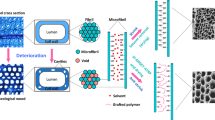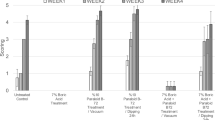Abstract
Furfuryl alcohol has a sufficiently small molecular size, which allows impregnation into wood and can be polymerized in the cell walls. Polymerization can be accomplished using a catalyst, heat or penetrating radiation. This research illustrates a natural wood polymer composite (NWPC) that was obtained under the catalytic effect of borates. Furfuryl alcohol (FA) and borates were mixed at different ratios before treatment. When borates alone are used, they were totally leached from wood after cyclic leaching periods. However, this was not encountered with the mixture of furfuryl alcohol and borates. Furfuryl alcohol considerably improved antiswelling efficiency by about 85% for both Japanese cedar ( Cryptomeria japonica) and Scots pine ( Pinus sylvestris L.) wood specimens. Results of the leaching tests of borate indicated that boric acid readily lost its boron content in the early cycles of the leaching periods and the highest leaching rate of boron was observed at the first leaching cycle (512 ppm). When furfuryl alcohol mixed with borates, boron was released to the leaching water at slower amounts, suggesting the possibility of longer protection of treated wood in service.
Similar content being viewed by others
References
Chen PYS, Puttmann ME, Williams LH, Stokke DD (1997) Treatment of hardwood lumber with borate preservation. Forest Prod J 47(6):63–68
Drysdale JA (1994) Boron treatments for the preservation of wood—a review of efficacy data for fungi and termites. The Intern Res Group on Wood Preservation, document IRG/WP, p 8
FAO (1986) Wood preservation manual. Mechanical Wood Products Branch, Forest Industries Division, Forestry Department, p 152
Frick JG, Andrews BAK, Reid J (1960) Effects of cross-linkage in wrinkle-resistant cotton fabrics. Textile Res J 30:495–504
Goldstein IS (1955) The impregnation of wood to impart resistance to alkali and acid. Forest Prod J 5(4):265–267
Goldstein IS (1960) Stable furfuryl alcohol impregnating solutions. Ind Eng Chem 52(1):57–58
Hafizoğlu H, Yalinkilic MK, Yildiz UC, Baysal E, Demirci Z, Peker H (1994) Utilizations of Turkey’s boron reserves in wood preservation industry. Project of the Scientific and Technical Research Council of Turkey, No TOAG-875, p 377
Hurwitz MD, Conlon LE (1958) Dialdehydes as cotton cellulose cross-linkers. Textile Res J 28:257–262
Japanese Standards Association (1991) Japanese industrial standard (JIS) A 9201. Qualitative standards and testing methods of wood preservatives. Japanese Standards Association, Tokyo
Knob A, Scheib W (1979) Chemistry and application of phenolic resins. Polymers/properties and applications. Springer, Berlin Heidelberg New York, p 269
Kubel H, Pizzi A (1982) The chemistry and kinetic behaviour of Cu-Cr-As/b wood preservatives. Part 6. Fixation of CCB in wood and physical and chemical comparison of CCB and CCA. Holzforsch Holzverw 34(5):80–86
Liang L, Takeshi F, Sadanobu K (2001) Leachability and decay resistance of tetraphenylborate salt-treated wood. Holzforschung 55:355–357
Liu X, Laks PE, Pruner MS (1997) A preliminary report on the wood preservative properties of phenylboronic acid. Forest Prod J 44(6):46–48
Lloyd JD, Dickinson DJ, Murphy RJ (1990) The probable mechanism of action of boric acid and borates as wood preservatives. International Research Group on Wood Preservation, No IRG/WP 97–40077, p 21
Manning MJ, Lloyd JD, Schoeman M (1997) The future of preservative and pesticide systems. In: Proceedings of the second international conference on wood protection with diffusible preservatives and pesticides, Proceeding No 7284, Forest Prod Society, USA, pp 157–168
Mathias L, Lee S, John R, Warren C (1991) Improvement of wood properties by impregnation with multifunctional monomers. J Appl Polym Sci 42:55–67
Mehta PC, Mody JR (1960) Reaction of dimethylol ethylene urea with cotton. Textile Res J 30:532–539
Meyers J (1981) Wood polymer materials: state of the art. Wood Sci 14(2):49–54
Murphy RJ (1990) Historical perspective in Europa. In: Hamel M (ed) Proceedings of the first international conference on wood protection with diffusible preservatives, Nashville, Tennessee, 28–30 Nov, pp 9–13
Murphy RJ, Barnes HM, Gray M (1995) Decay and soil depletion studies with polymer/boron preservatives system. Forest Prod J 45(9):77–81
Nagao T, Wada K, Kuwagata M, Ono H (2000) Effects of prenatal and postnatal exposure to styrene dimers and trimers on reproductive toxicology. Toxicol Lett 158(5):403–415
Nicholas D, Jin L, Preston AF (1980) Immediate research needs for diffusible boron preservatives. In: Proceedings of the first international conference on wood protection with diffusible preservatives. Nashville, Tennessee, 28–30 Nov, pp 121–123
Ozaki SK (1999) Effects of furfuryl alcohol combined with boron compounds treated wood. MS Thesis, Physical Institute of Sao Carlos, University of Sao Paulo
Ozaki SK, Yalinkilic MK, Imamura Y, Souza MF (2001) Effect of combined boron compounds and furfuryl alcohol treatment on termite and decay resistance in wood. In: Imamura Y (ed) High-performance utilization of wood for outdoor uses. Report on research project. Grant-in-aid for scientific research, Kyoto, pp 97–103
Peylo A, Welleitner H (1995) The problem of reducing the leachability of boron by water repellents. Holzforschung 49(3):211–216
Peylo A, Welleitner H (1997) Leaching of boron more than 3 years of field exposure. International Research Group on Wood Preservation, No IRG/WP 97–30143, Stockholm, Sweden, p 7
Pizzi A, Baecker A (1996) A new boron fixation mechanism for environmentally friendly wood preservatives. Holzforschung 50(6):507–510
Renwick AG, Walton K (2001) The use of surrogate endpoints to assess potential toxicity in humans. Toxicol Lett 120(1–3):97–110
Rowell RM (1984) Penetration and reactivity of cell wall components. In: Rowel RM (ed) The chemistry of solid wood. Advances in the chemistry series 207. American Chemical Society, pp 175–210
Rowell RM, Konkol P (1987) Treatments that enhance physical properties of wood. Gen Tech Rep, FPL-GTR-55, US Department of Agriculture, Forest Service, Forest Products Laboratory, Madison, WI, p 12
Ryu JY, Imamura Y, Takahashi, M (1992) Biological resistance of phenolic resin treated wood incorpaorating boric acid impregnation. In: Chemical modification of Lignicellulosics. Rotarua, New Zealand
Schneider MH (1995) New cell wall and cell lumen wood polymer composites. Wood Sci Technol 29:121–127
Small H (1989) Ion chromography. In: Hercules D (ed) Modern analytical chemistry series. Plenum, New York, pp 276
Su WY, Yalinkilic MK, Hata T, Imamura Y, Ishihara S (1997) Enhancement of leach and termite resistances of plywood treated with boric acid compounds. Mokuzai Gakkaishi 43(7):595–601
Thevenon M, Pizzi FA, Haluk JP (1997) Non toxic albumin and soja protein borates as ground-contact wood preservatives. Holz Roh Werkst 55(2):293–296
Thevenon MF, Pizzi A, Haluk JP (1998) Protein borates as non toxic, long-term, wide spectrum ground contact wood preservatives. Holzforschung 52(3):241–248
Toussaint-Dauvergne E, Soulounganga P, Gerardin P, Loubinoux B (2000) Glycerol/glyoxal: a new boron fixation system for wood preservation and dimensional stabilization. Holzforschung 54:123–126
Yalinkilic MK, Baysal E, Demirci Z (1995a) Effect of boron preservatives on hygroscopicty of brutia pine wood. Pamukkale University Denizli, Turkey, Engineering Science J 1(2–3):161–168
Yalinkilic MK, Baysal E, Demirci Z (1995b) Effect of boron preservatives of hygroscopicity properties of douglas fir wood. In: Proceedings of the first black sea forestry II, pp 47–60
Yalinkilic MK, Baysal E, Demirci Z (1997a) Water uptake and water-repellency of douglas fir treated with boron compounds. In: Proceedings of the XI world forestry congress, 13–22 Oct, Antalya, vol 4, p 45
Yalinkilic MK, Yoshimura T, Takahashi M, Sudiyani Y (1997b) Phenylboronic acid treatment of wood. Abstracts of 47th annual meeting of Japan wood research society, Kochi, Japan, p 420
Yalinkilic MK, Tsunoda K, Dwianto W, Inoue M, Tanaka F, Takahashi M (1998a) Effect of hot-compression of boron treated wood at radial direction on boron leachability. Proceedings of the second international wood science seminar, 6–7 Nov, Serpong, Indonesia, p 69–79
Yalinkilic MK, Yoshimura T, Takahashi M (1998b) Enhancement of the biological resistance of wood by phenylboronic acid treatment. Wood Sci 44(2):152–157
Yalinkilic MK, Tsunoda K, Takahashi M, Gezer ED, Dwianto W, Nemato H (1998c) Enhancement of biological and physical properties of wood by boric acid-vinyl monomer combination treatment. Holzforschung 52(6):667–672
Yalinkilic MK, Imamura Y, Takahashi M, Yalinkilic AC (1999a) In situ polymerization of vinyl monomers during compressive deformation of wood treated with boric acid to delay boron leaching. Forest Prod J 49(2):43–51
Yalinkilic MK, Takahashi M, Imamura Y, Gezer ED, Demirci Z, İlhan R (1999b) Boron addition to non or low formaldehyde cross-linking reagents to enhance biological resistance and dimensional stability for wood. Holz Roh Werkst 57(1):351–357
Yalinkilic MK (2000) Improvement of boron immobility in the borate treated wood and composite materials. PhD Thesis, Kyoto University, p 151
Yun RJ (1991) Improvement of biological resistance and some physical properties of wood by resin-based treatments and its application to particle board production. PhD Thesis, Kyoto University, p 110
Yusuf S, Imamura Y, Takahashi M, Minota K (1995). Biological resistance of wood chemically modified with non-formaldehyde cross-linking agents. Mokuzai Gakkaishi 41(2):163–166
Author information
Authors and Affiliations
Corresponding author
Rights and permissions
About this article
Cite this article
Baysal, E., Ozaki, S.K. & Yalinkilic, M.K. Dimensional stabilization of wood treated with furfuryl alcohol catalysed by borates. Wood Sci Technol 38, 405–415 (2004). https://doi.org/10.1007/s00226-004-0248-2
Received:
Published:
Issue Date:
DOI: https://doi.org/10.1007/s00226-004-0248-2




